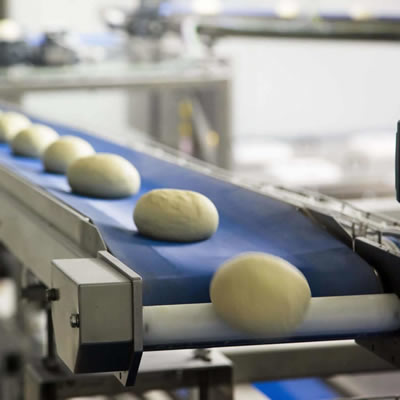How does dough conveying work?
Dough conveying systems fills the gap between the mixer and the dough dividing equipment. It is a smooth-handling system that moves dough from one stage to another in an efficient and productive way.
Bulk or large amounts of dough coming from mixers can be moved by using:
- A band or belt conveyor that normally connect dividers with rounders, and rounders with the rest of the production equipment down the line.
- An auger or endless screw, also known as a dough pump. Often connecting mixers and dividers, this type of conveying equipment is commonly used in continuous mode production environments. It requires a high level of automation and is usually found in large-scale production bakeries such as white pan bread production plants.
Discrete or single pieces of specially shaped dough, can only be moved by band or belt conveyors.
Conceptually speaking, dough conveyors are the “bridge” of the production line. The following is a good example of a straight dough concept:
Horizontal mixer →* Divider → Rounder → Intermediate Proofer → Sheeter/Moulder → Panner → Proofer → Splitter → Oven
*The arrow symbol (→) represents dough conveying systems.
Since the oven turns raw dough into bread by baking, we cannot use the term “dough conveying” system after this step.
In a high-speed bakery plant, dough conveying systems are fully mechanized and are usually connected to the supervisory control and data acquisition system (SCADA). These conveyors are then centrally supervised and controlled electronically. In some cases, dough conveying systems are used occasionally or temporarily (e.g., in production peaks), and hence may not require permanent connection to the line. However, they may still need to be set manually, e.g., belt speed.
Food safety and quality considerations
- Whether the conveying equipment is designed as closed or open equipment, it should as any other product-contact surface, allow for maintenance, inspection, cleaning and sanitation activities to be performed easily, adequately and quickly to reduce downtime.
- Dough conveying equipment should be properly designed, constructed and installed so as to preserve food safety in the production environment. This is important since dough pickups on conveyor surfaces could cause cross-contamination if various types of bakery products (allergenic or gluten-free) are processed in the same line (shared line).
- Dusting flour and/or oiling conveyor product-contact surfaces to manage wet and sticky doughs are possible options, but the costs of doing so should be appropriately considered. The design of the food-grade material used as band or belt should be such that minimizes dough pickup.
- If equipment units inside production line are connected through dough conveyors, e.g., mixer and divider, the design and operation of the conveying equipment should minimize transfer times and distances between equipment units. In bread and rolls production bakeries, the fully developed and fermented dough should not be allowed to stand more than 20 minutes without making it to the rounding step.1
References
- AIB International. Bread Manufacturing Process, Distance Learning Course, “Part 2 Module 01 – Dividing.” https://www.aibonline.org/Start-Your-Training/Baking/Baking-Foundations/Bread-Manufacturing-Process-Online, 2018.

